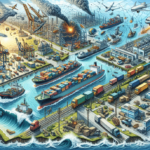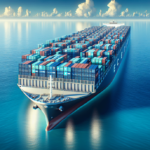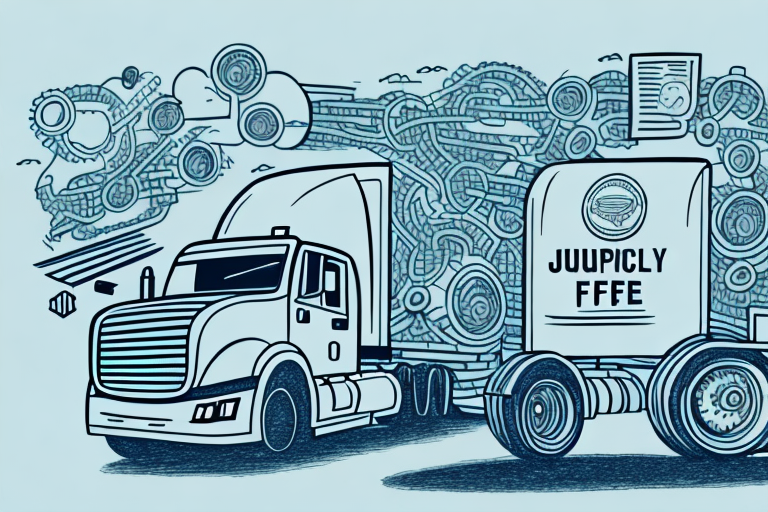Retailers Take to Air Freight to Overcome Ocean Delays, Resulting in Higher Emissions
The retail industry continues to grapple with ongoing disruptions, particularly those caused by delays in ocean shipping. These delays have significantly extended shipment wait times, hindering the timely delivery of products to customers. This bottleneck has had a cascading effect throughout the supply chain, especially impacting small retailers lacking the resources to manage such challenges efficiently.
Understanding the Impact of Ocean Delays on Retailers
The COVID-19 pandemic has been the primary catalyst for the surge in ocean shipping delays. The widespread closure of manufacturing facilities, alongside a spike in consumer demand, has created a perfect storm leading to congested ports and extended transit times. With the global container shortage intensifying, retailers are facing increased shipping costs and are compelled to seek alternative transportation methods, such as air freight, to meet consumer demands.
According to a 2023 industry report by ShipScience, port congestion has increased by 25% since 2020, contributing to average shipment delays of up to 30 days. These delays have resulted in inventory shortages and stockouts, leading to lost sales, reduced revenue, and diminished customer trust. To mitigate these effects, retailers are adopting strategic inventory management practices and diversifying their supply sources.
The Environmental Consequences of Ocean Freight Shipping
While ocean freight remains the most cost-effective method for transporting large volumes of goods, it carries significant environmental repercussions. Ocean shipping is responsible for approximately 2.5% of global carbon dioxide emissions, emitting more CO₂ per tonne-mile compared to air freight and road transportation. Additionally, ships release harmful pollutants such as nitrogen oxides (NOx) and sulfur oxides (SOx), which contribute to air pollution and acid rain.
The rise of fast fashion and consumer expectations for free shipping have further exacerbated the environmental impact by increasing packaging waste and overall consumption. Such practices not only affect retailers but also have broader implications for the planet’s health.
Moreover, ocean shipping adversely affects marine ecosystems. Noise pollution from ships disrupts the communication and behavior of marine mammals like whales and dolphins. The industry also plays a role in the spread of invasive species, as organisms hitching rides on ship hulls can be transported to new, often vulnerable environments, threatening native species.
For more insights into the environmental impact, see the EPA’s report on greenhouse gas emissions from ocean freight.
Air Freight: A Solution to Meet Customer Demand
In response to ocean shipping delays and environmental concerns, retailers are increasingly adopting air freight as an alternative. Although air freight is more expensive, it offers faster and more reliable delivery times, which are crucial for maintaining customer satisfaction.
Statistics show that air freight delivery times are reduced by up to 60% compared to ocean shipping. This speed allows retailers to replenish inventory swiftly, especially during peak shopping seasons, thereby preventing stockouts and ensuring that consumer demand is consistently met.
With the expansion of e-commerce, consumers now expect rapid delivery, making air freight an attractive option despite its higher costs. Retailers leveraging air freight can better compete in the fast-paced market, offering timely product availability and enhancing the overall customer experience.
For more information on air freight benefits, visit ShipScience’s air freight solutions.
Comparing the Costs and Benefits of Air Freight vs. Ocean Freight
Choosing between air freight and ocean freight involves a careful analysis of costs and benefits tailored to a retailer’s specific needs.
- Air Freight: Higher cost, usually calculated based on weight and volume; faster delivery times which reduce inventory holding costs; lower carbon footprint for short-distance shipments.
- Ocean Freight: More cost-effective for large shipments; longer delivery times require effective inventory management; higher carbon emissions per tonne-mile but potentially lower emissions when shipping in bulk.
Retailers must evaluate factors such as shipment size, urgency, destination, and environmental priorities when making this decision. Additionally, considering the total cost of ownership—including inventory holding costs and potential lost sales due to delays—can provide a more comprehensive comparison.
For a detailed cost-benefit analysis, refer to ShipScience’s comparison tool.
Technological Innovations to Reduce Supply Chain Emissions
While air freight offers a short-term solution to shipping delays, it is not sustainable in the long run due to its environmental impact. Advancements in technology present opportunities to reduce emissions across the supply chain.
- Cargo Consolidation: Combining multiple shipments into a single container reduces the number of voyages needed, lowering overall emissions.
- Route Optimization: Using software to determine the most efficient shipping routes minimizes fuel consumption and emissions.
- Alternative Fuels: Transitioning to biofuels, hydrogen, and other renewable energy sources can significantly decrease the carbon footprint of shipping operations.
- Autonomous Vehicles and Drones: Implementing these technologies can enhance shipping efficiency and reduce reliance on traditional fuel-powered transportation.
Furthermore, the integration of blockchain technology in supply chain management increases transparency and traceability, enabling better decision-making to minimize waste and emissions.
Explore more about how technology is reshaping sustainable shipping at ShipScience’s technology insights.
The Future of Sustainable Shipping in Retail
As the retail sector navigates the complexities of modern supply chains, the emphasis on sustainable shipping practices is intensifying. Consumer demand for eco-friendly products and transparent business practices is driving retailers to prioritize sustainability in their operations.
Future trends in sustainable shipping include the adoption of electric and hybrid vehicles, investment in alternative fuels like biofuels and hydrogen, and the development of circular packaging systems that promote reuse and recycling.
Retailers must optimize their supply chain processes, integrate renewable energy sources into their operations, and collaborate closely with suppliers and freight carriers to achieve sustainability goals. These measures not only reduce environmental impact but also enhance brand reputation and customer loyalty.
For trends on sustainable shipping, visit ShipScience’s sustainability page.
Balancing Profitability with Sustainability Challenges
Implementing sustainable practices often involves balancing profitability with environmental responsibility. Retailers must manage the costs associated with sustainability initiatives while ensuring they remain competitive in the market.
One significant challenge is the disparity between consumer demand for sustainability and their willingness to pay a premium for eco-friendly products. Although there is a growing trend towards environmentally responsible buying, many consumers still prioritize price and convenience, making it difficult for retailers to justify higher investments in sustainable practices without clear long-term benefits.
To overcome this, retailers can focus on integrating cost-effective sustainable practices, leveraging technology for efficiency gains, and educating consumers about the benefits of sustainable products to foster greater demand.
E-commerce’s Influence on Shipping Solutions
The explosive growth of e-commerce has heightened the need for fast, efficient, and reliable shipping solutions. Consumers now expect quick delivery times, prompting retailers to invest in logistics that can meet these expectations without compromising sustainability.
Strategies to address this include leveraging regional warehouses to shorten delivery distances, employing advanced logistics software for better routing, and adopting multi-modal transportation solutions to optimize both speed and environmental impact.
As e-commerce continues to expand, the demand for innovative shipping solutions that balance speed, cost, and sustainability will become increasingly critical for retailers.
Importance of Collaboration in Sustainable Supply Chains
Effective collaboration among retailers, suppliers, and freight carriers is essential for implementing sustainable and efficient supply chain practices. By working together, stakeholders can identify and address inefficiencies, share sustainable technologies, and establish shared sustainability goals.
This collaboration facilitates the adoption of best practices across the entire supply chain, from sourcing to delivery. It also enables the development of integrated solutions that reduce carbon emissions and enhance operational efficiency.
For more on fostering collaboration, visit ShipScience’s collaboration strategies.
Is Air Freight a Sustainable Long-Term Solution?
While air freight provides a necessary stopgap for overcoming ocean shipping delays, it is not a sustainable long-term solution due to its high costs and substantial carbon emissions. Retailers must seek alternative strategies to create resilient and sustainable supply chains.
Investing in sustainable supply chain practices, such as utilizing more efficient transportation modes, optimizing inventory management, and embracing green technologies, can help retailers reduce their reliance on air freight and minimize their environmental impact.
Ultimately, building a sustainable supply chain requires a multifaceted approach that integrates various strategies to balance speed, cost, and environmental responsibility.
The Long-Term Effects of Covid-19 on Global Supply Chains
The Covid-19 pandemic exposed vulnerabilities within global supply chains, underscoring the need for more resilient and sustainable shipping solutions. Retailers are now prioritizing strategies that enhance supply chain flexibility and sustainability to better withstand future disruptions.
This involves diversifying supply sources, investing in supply chain technologies that improve transparency and efficiency, and adopting sustainability as a core component of business strategy.
By addressing the lessons learned during the pandemic, retailers can build more robust supply chains that support long-term sustainability and operational resilience.
Strategies for Retailers to Minimize Carbon Footprint
Retailers can significantly reduce their carbon footprint by implementing sustainable practices throughout their supply chain operations. Key strategies include:
- Investing in fuel-efficient transportation vehicles and alternative energy sources.
- Adopting circular packaging systems that prioritize reuse and recycling over single-use materials.
- Reducing overall waste through optimized inventory management and efficient resource utilization.
- Promoting responsible sourcing by selecting suppliers committed to sustainable practices.
By prioritizing these practices, retailers can align their operations with consumer expectations for sustainability, while also contributing to environmental preservation.
Learn more about sustainable practices at ShipScience’s sustainability tips.
Innovative Approaches to Mitigate Supply Chain Disruptions and Emissions
To effectively combat supply chain disruptions and reduce emissions, retailers are exploring innovative strategies, such as:
- Data Analytics: Utilizing advanced data analytics to optimize supply chain operations, identify inefficiencies, and make informed, data-driven decisions.
- Alternative Delivery Modes: Exploring ocean-to-rail and intermodal transportation solutions to minimize environmental impact while maintaining delivery efficiency.
These strategies enable retailers to enhance supply chain resilience, reduce emissions, and maintain operational efficiency even amidst ongoing disruptions.
For more innovative strategies, visit ShipScience’s innovation page.
In conclusion, retailers face significant challenges in balancing the need for swift, efficient shipping solutions with the imperative to adopt sustainable practices. The pandemic has intensified these challenges, resulting in ocean shipping delays and increased emissions. By fostering collaboration with suppliers and freight carriers, leveraging new technologies, and embracing sustainable practices, retailers can navigate these challenges and contribute to a more sustainable future.






















